Salah I. Yahya, Yazen A. Khalil
Department of Software Engineering, Faculty of Engineering, Koya University, University Park, Danielle Mitterrand Boulevard, Koya KOY45, Kurdistan Region of F.R. Iraq
Correspondence to: Salah I. Yahya, Department of Software Engineering, Faculty of Engineering, Koya University, University Park, Danielle Mitterrand Boulevard, Koya KOY45, Kurdistan Region of F.R. Iraq.
| Email: |  |
Copyright © 2015 Scientific & Academic Publishing. All Rights Reserved.
Abstract
The scenario of making a mobile phone call inside a vehicle is numerically modeled using a high resolution FDTD gridding; solved by a 3-D full-wave electromagnetic simulation software on a high performance workstation machine with Tesla GPU accelerator. The simulated mobile call inside a vehicle involved; a high resolution human head with shoulder phantom (VH_Head_Model 9), high resolution realistic hand model (posable right-hand), realistic mobile phone handset CAD-models with different antenna types and a vehicle CAD-model (big-sedan Camaro-brand). The impact of the in-vehicle mobile calls on the electromagnetic interaction of the handset antenna and human is anticipated at different operating frequencies, i.e., GSM-900 and GSM-1800, and different handset positions with respect to head, i.e., cheek and tilt-position. A significant degradation in the handset antenna performance was observed due to the presence of the vehicle body while making a mobile call inside. Nevertheless, no change in the peak spatial-average specific absorption rate in head tissues was detected while making a mobile call inside vehicle, as compared with the specific absorption rate due to the mobile call in free-space.
Keywords:
Antenna efficiency, Human phantom, Mobile antenna, Mobile phone, SAR, TIS
Cite this paper: Salah I. Yahya, Yazen A. Khalil, High Resolution Numerical Modelling of In-Vehicle Mobile Calls, International Journal of Electromagnetics and Applications, Vol. 5 No. 1, 2015, pp. 66-72. doi: 10.5923/j.ijea.20150501.05.
1. Introduction
The electromagnetic (EM) interaction of the mobile phone handset antenna and human was projected by many researchers during the past two decades after launching the second generation of the cellular communication commercially in 1991 in Finland and then spread all over the world. Different factors may impact this EM interaction and consequently presented by two mutual effects, one is on the handset antenna performance and the second is on the induced specific absorption rate (SAR) level inside the user’s head tissues. Although the different factors may affect the EM interaction of handset antenna and human head have been examined extensively by many researchers in several publications, but no academic papers are published yet about the impact of in-vehicle mobile calls with realistic modelling of the vehicle, human body and mobile phone. This is due to the large number of Finite-Difference Time-Domain (FDTD) grid cells of the numerical modelling that needs a high performance machine with accelerator hardware. Anzaldi analyzed the effect of the vehicle metallic structure body on the induced SAR inside a complete human body due to the EM radiation of a dipole antenna working at 835MHz and placed at different locations inside the vehicle [1]. Ruddle investigated the impact of source location and human occupancy configurations on in-vehicle SAR levels due to 400 and 900MHz on board transmitters [2-3]. Diao evaluated the SAR in the scenarios of passengers using different wireless communication devices inside a vehicle. The effects of the devices with different operational frequencies 900MHz/1.8GHz/2.4GHz, and different seating locations on the SARs were investigated [4]. A simple metal frame was used to simulate the vehicle. A block model for the body and sphere model for the head were used to simulate the human complete body. The generic phone was used in a vertical position and placed in close vicinity to head, but not according to the recommended positions by the IEEE [5], i.e., check and tilt. Yahya anticipated the EM interaction of the handset antenna and a human while making a mobile call inside a car at frequency of 1900MHz [6]. Yahya used a generic phone to simulate the mobile phone with a homogeneous head model (SAM) to simulate the user’s head.None of the above mentioned researchers used realistic mobile phone models, with internal or external antenna structures, where a generic phone or a dipole antenna was used to simulate the mobile phone. The impact, while making a mobile call inside a vehicle, on the handset antenna performance was not investigated, but by Yahya [6].In this paper the EM interaction of different realistic mobile phone models having different antenna types, grasped by anatomical hand model in close proximity to anatomical head model at cheek and tilt positions while making a call at 900 and 1800MHz inside a vehicle are investigated. The presence of the human body phantom is simulated by a head and shoulder only, since the handset antenna near field radiation is mainly interacted with the presence of head, shoulder and hand-hold rather than the other parts of the user’s body.The remainder of the paper is organized as follow. In Section 2, the standards for SAR limits due to the wireless communication devices are listed. In Section 3, the numerical approach and computational requirements are styled. In Section 4, the numerical models involved in the numerical dosimetry are presented. In Section 5, the FDTD grid generation needed to realize the study case using FDTD method is given. In Section 6, the numerical results are illustrated and discussed. Finally, Section 7 concludes the paper.
2. SAR Safety Limits
The effect of the EM radiation of the wireless communication devices is evaluated by means of computing the SAR induced in the human head/body tissues in terms of the peak spatial-average SAR over 1 or 10 g in the human head or the averaged SAR over the whole body. Different standards that belong to different countries are setting different SAR exposure limits [7]-[11]. Table 1 lists the SAR limits for the non-occupational users recommended in USA and Europe. Only the 1g SAR results relating to the IEEE standards will be presented in this paper, since the 1g SAR limits are stricter than the 10g SAR limits.Table 1. SAR limits for non-occupational/unaware users in different countries and regions
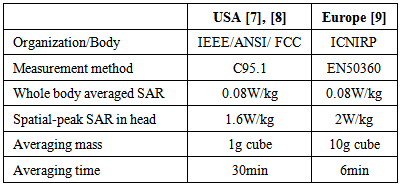 |
| |
|
3. Numerical Approach
The numerical dosimetry of the mobile phone while making a call inside vehicle was achieved using the FDTD method that proposed by Kane Yee in 1966 [12]. A licensed EM simulation platform - EM software, SEMCAD X, version 14.8.6 Aletsch, commercially available from SPEAG [13] was selected and used for numerical computation. A high performance workstation machine (hp Z420) [14] with NVIDIA Quadro K2000 graphic card is used, and accelerated by a Tesla® GPU® K20 [15] using NVIDIA CUDA driver and based on the NVIDIA Kepler™ Architecture.
4. Numerical Models
4.1. Mobile Phone Numerical Models
Four mobile phone handset models were considered and designed for the numerical dosimetry and the EM interaction inside vehicle; two candy-bar handsets with external antenna (model-A) working at 900 and 1800MHz and two candy-bar handsets with internal antenna (model-B) working at 900 and 1800MHz [16]. The antenna physical dimensions and the handset parts electrical properties of the four handset models that given in [16] were used. Fig. 1 shows the SEMCAD X representation of the both handset model-A and B. Fig. 2 shows the reflection coefficient |S11| versus frequency of the four handset models at the adopted frequencies.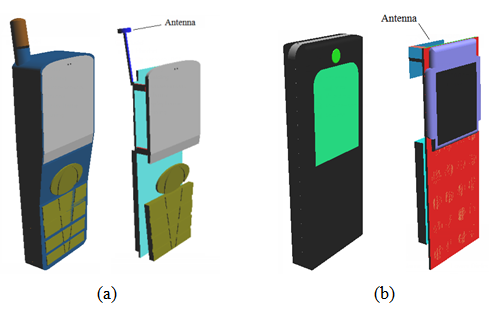 | Figure 1. The SEMCAD X representation of the handset showing different components; (a) Handset model-A with external antenna and (b) Handset model-B with internal antenna |
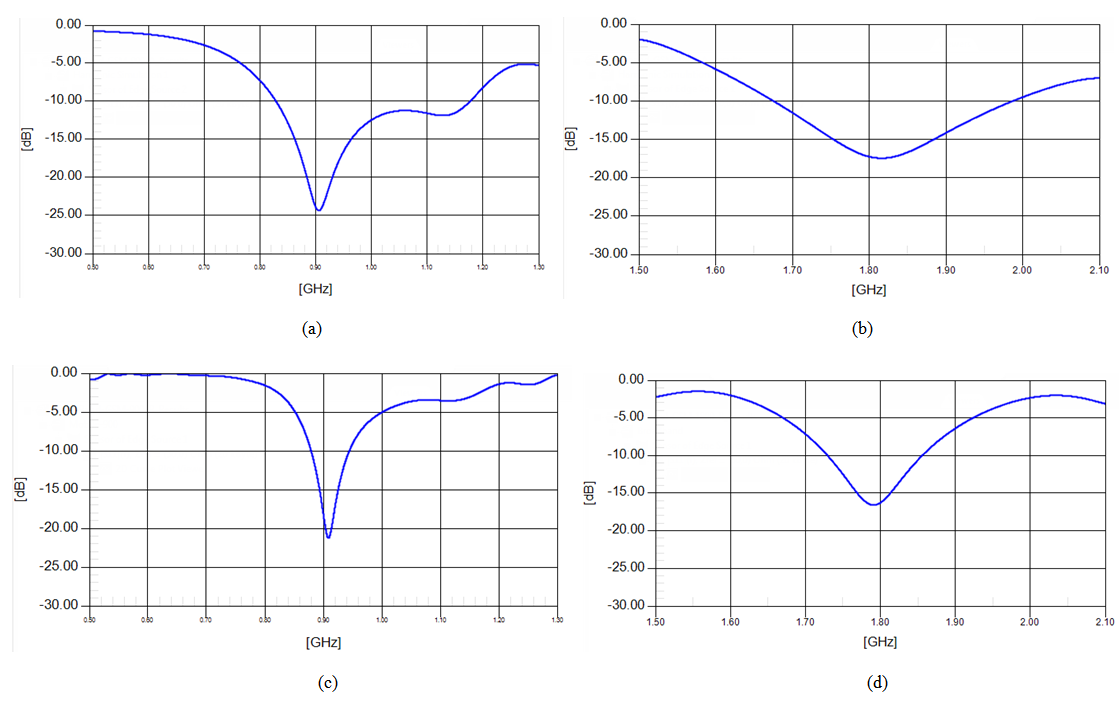 | Figure 2. |S11| in dB versus frequency of; (a) Handset model-A at 900MHz, (b) Handset model-A at 1800MHz, (c) Handset model-B at 900MHz and (d) Handset model-B at 1800MHz |
4.2. Human Hand Numerical Models
A realistic posable right-hand model composed of three tissues; skin, muscles and bones, available from SPEAG [13], was used in the numerical dosimetry. Fig. 3 shows the hand model grasping the two mobile phone models. The material permittivity and electrical conductivity of the hand tissues were set according to the material database available with SEMCAD X [13].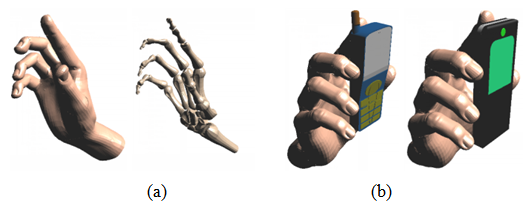 | Figure 3. Perspective views of (a) Posable right-hand model, all tissues and bone only and (b) Posable right-hand grasping the two handset models in different views |
4.3. Human Head Numerical Model
An anatomically realistic 3D model of human head and shoulder (VH_head) of 38 years old male, based on the Visible Human Project and available with SEMCAD X [13], has been used in this paper. A 52 recognized tissues of the VH_head model were defined according to the material data base available in [13]. The head data has a 2mm resolution. Fig. 4 shows the VH_head model with different tissues in addition to the voxalized model using FDTD. | Figure 4. The anatomical human head and shoulder model of VH; (a) The total tissue, (b) Bone tissue, (c) Muscles tissue and (d) Voxalized head model using FDTD method |
4.4. Vehicle Numerical Model
A CAD-model of a big sedan “Chevrolet Camaro” available commercially is used to simulate the vehicle. The Chevrolet Camaro dimensions are set equal to; 4837mm length, 1917mm width and 1360mm height [17]. Four different materials were recognized in the CAD model to simulate all car-materials; metal, plastic, glass and leather. Fig. 5 shows different perspective views of the Camaro model.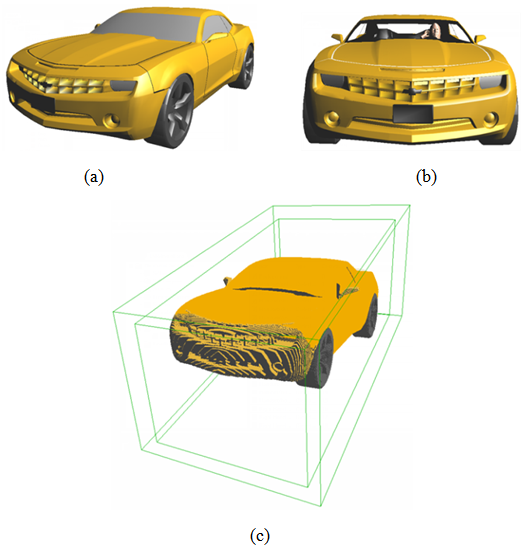 | Figure 5. (a) and (b) Different perspective views of the Camaro-brand vehicle, including the mobile phone in hand close to head phantom, used for the numerical dosimetry and (c) The visualization of voxels after gridding of the handset at cheek-position inside the vehicle (254.311 Mcell) |
5. FDTD Grid Generation
Five different scenarios were considered to anticipate the EM interaction of the handset antenna and user’s head while setting a mobile call inside a vehicle;1. Handset in free-space. 2. Handset in hand and in close proximity to head at check-position making a call in free-space.3. Handset in hand and in close proximity to head at tilt-position (15°) making a call in free-space.4. Handset in hand and in close proximity to head at cheek-position making a call inside vehicle.5. Handset in hand and in close proximity to head at tilt-position (15°) making a call inside vehicle.These five scenarios were repeated for both model-A and model-B, at 900 and 1800MHz frequency. For the FDTD grid setting, a minimum spatial resolution of 0.5mm was set in the x, y, and z directions. The absorbing boundary conditions (ABCs) are set as a uniaxial perfectly matched layer (UPML) mode with a very high strength thickness, where minimum level of absorption at the outer boundary is (>99.9%). Fig. 6 shows the hand-held mobile phone, model-A and model-B, in close proximity to head at cheek and tilt position. | Figure 6. The mobile phone handset model-A and model-B at different position with respect to head and according to IEEE (IEEE-Std. 1528, 2003) |
For the different scenarios, the minimum FDTD grid-cell size was 13.0072Mcell, whereas, the maximum was 254.311 Mcell. These required a minimum processing time of 00:01:58 (hh:mm:ss) and a maximum of 05:50:41, respectively. The processing time mainly depends on the grid-cell size that depends on the problem size, and frequency.
6. Numerical Results and Discussion
The impact of in-car mobile phone call on the EM interaction of the handset antenna and user’s head was evaluated from two different perspectives; first, the antenna performance, i.e., total efficiency and total isotropic sensitivity (TIS) and total radiated power (TRP), second, the specific absorption rate (SAR1g) induced in the user's head.
6.1. Mobile Phone Total Efficiency
The impact of making a mobile phone inside a vehicle on the antenna total efficiency [18] is revealed by the numerical results sketched in Fig. 7. As shown in Fig. 7, the handset antenna total efficiency deteriorated dramatically while making a call inside vehicle. At a frequency of 900MHz, more deterioration in the antenna total efficiency appears with the handset model-B while making a call inside vehicle, whereas, at the frequency of 1800MHz more deterioration appears in the total efficiency of the handset antenna of model-A, as compared with the call outside vehicle. Moreover, handsets model-B at 900 and 1800MHz, and model-A at 900MHz show more deterioration in the antenna total efficiency at cheek-position, as compared with the same setup at tilt-position, while making a call outside or inside vehicle, whereas, the scenario is opposite for the handset model-A at 1800MHz. | Figure 7. The handset antenna total efficiency of both model-A and model-B while making a call in different scenarios |
6.2. Mobile Phone TIS
The TIS is a measure of the handset receiving performance, where both TIS and TRP together determine the effectiveness of the handset as a piece of radio equipment, in particular the maximum range at which the handset can operate from the base station with some given level of performance [19]. As compared with the normal receiver sensitivity in GSM systems, a typical specification for the TIS is around 10-12dBm higher in talk position [20], [21]. Fig. 8 shows the TIS values for the different scenarios. | Figure 8. The handset TIS (dBm) of both model-A and model-B while making a call in different scenarios |
The same deterioration scenario seen with antenna total efficiency has also been seen with the TIS. The lowest TIS value was recorded for handset model-A at tilt-position working at 1800MHz inside vehicle, i.e., -87.3dBm, which is 18.2dBm higher than the recorded normal receiver sensitivity, i.e., -105.5dBm.
6.3. SAR in User’s Head Tissues
Fig. 9 shows the peak spatial-average SAR1g (W/kg) induced in head tissues due to the EM antenna radiation of both handset model-A and model-B at 900 and 1800MHz normalized to 250 and 125mW, respectively. | Figure 9. The peak-spatial SAR1g induced in head tissues due to both model-A and model-B handsets while making a call in different scenarios. The SAR1g values are normalized to 250 and 125mW at 900 and 1800MHz, respectively |
It is obvious that the presence of the vehicle metal body with other materials while making a mobile call has no effect on the induced SAR1g in the user’s head, as compared with the call in free-space.
6.4. Total Radiated Power
The mobile base-station needs a minimum of 1mW (0.0dB), power level number 15, to be connected successfully with the handset terminal [22]. Fig. 10 shows the TRP of both handset model-A and model-B in different scenarios. | Figure 10. The TRP (mW) of both model-A and model-B while making a call in different scenarios. The TRP values are normalized to 250 and 125mW at 900 and 1800MHz, respectively |
Although both handsets could establish a successful mobile call inside vehicle due to the TRP over 1mW, still the mobile call of handset model-A at tilt-position, working 1800MHz inside vehicle presents a critical connection due to the additional free-space loses, where a minimum TRP is recorded, i.e., 1.7mW.Fig. 11 shows the antenna electric field radiation pattern of both handset models in different scenarios inside vehicle.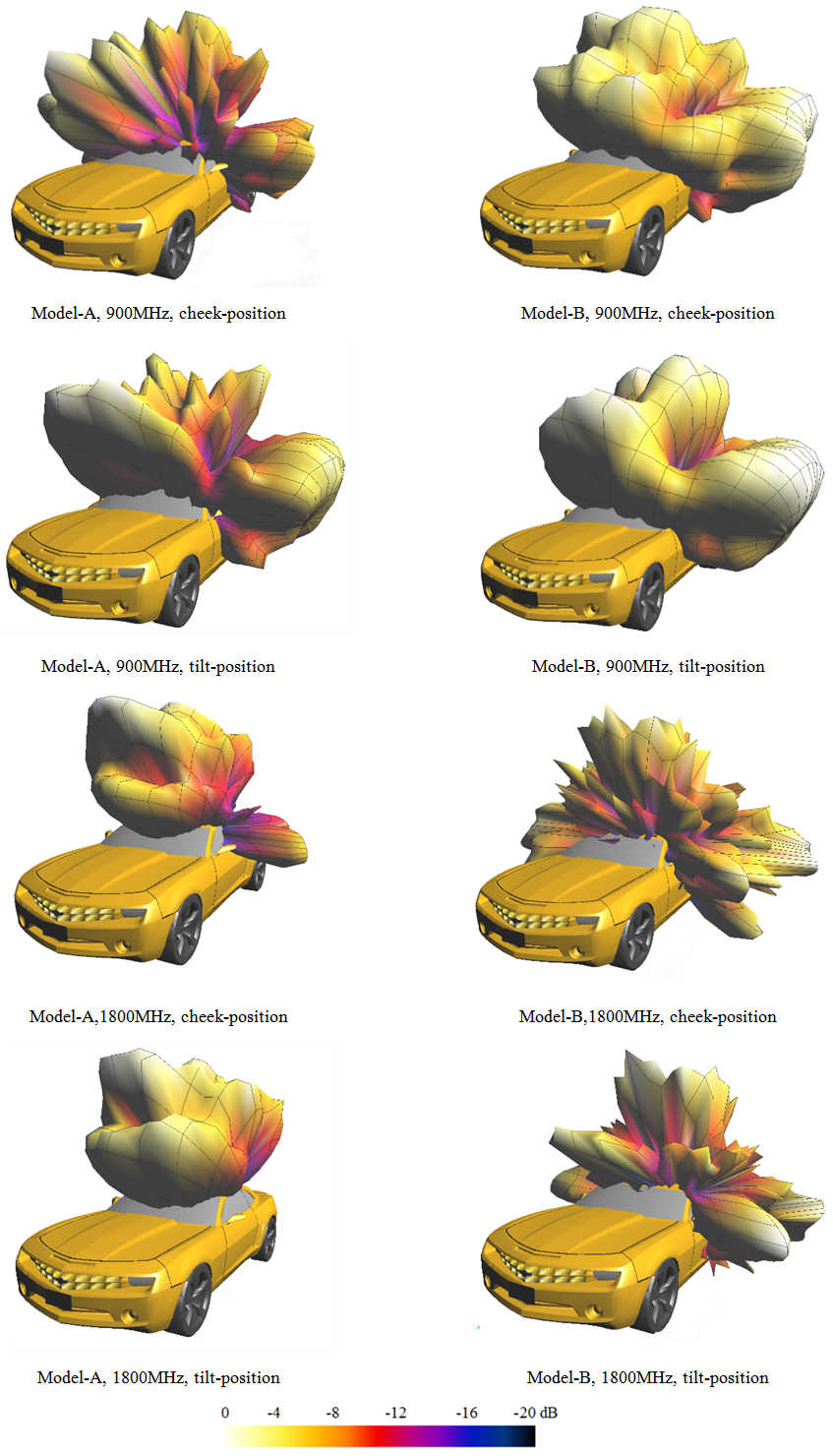 | Figure 11. The antenna electric field radiation patterns of both handset model-A and model-B at different positions with respect to head, working at 900 and 1800MHz inside the Camaro-brand vehicle |
The numerical results achieved in this paper showed that while making a call inside vehicle, the performance of handset antenna with external antenna, i.e., model-A, is affected more at 1800MHz and less at 900MHz, as compared with the performance of the handset with internal antenna, i.e., model-B. Although the results of model-A scenarios are coincides with the results achieved by Yahya [6], using a generic phone working at 1900MHz and SAM head model, but the numerical results of realistic handset model of external antenna and anatomical head model throughout this paper showed a sufficient TRP value to establish a successful call with the mobile base-station which does not request the handset to increase its input power. This will keep the SAR1g level in head tissues, which is already the same level of the call case in free-space.
7. Conclusions
The high resolution numerical dosimetry of two mobile phone handset models, with external and internal antennas and working at GSM-900 and GSM-1800 frequencies while making a call inside vehicle (a big sedan Chevrolet Camaro), showed no increase in the peak spatial-average SAR over 1g induced in the user’s head tissue, as compared with the call in free-space. Although the GSM-1800 handset of external antenna while making a call inside-vehicle at cheek and tilt-position showed more degradation in total radiated power, but still this handset is able to initiate a successful call with mobile base-station.
References
| [1] | G. Anzaldi F. Silva, M. Fernandez, M. Quilez, and P. Riu, “Initial analysis of SAR from a cell phone inside a vehicle by numerical computation,” IEEE Transactions on Biomedical Engineering, vol. 54, no 5, pp. 921-930, 2007. |
| [2] | A.R. Ruddle, “Computed SAR distributions for the occupants of a car with a 400 MHz transmitter on the rear seat,” in Proc. 18th International Zurich Symposium on Electromagnetic Compatibility, EMC Zurich 2007. |
| [3] | A.R. Ruddle, “Computed SAR levels in vehicle occupants due to on-board transmissions at 900 MHz,” in Proc. of Antennas & Propagation Conference, Loughborough, 2009, p. 137. |
| [4] | Y. Diao, W. Sun, K. Hung Chan, S. Leung, and Y. Siu Y, “SAR evaluation for multiple wireless communication devices inside a vehicle,” in Proc. of 2013 URSI International Symposium on Electromagnetic Theory (EMTS), 2013, p. 626. |
| [5] | (2003) IEEE recommended practice for determining the peak spatial-average specific absorption rate (SAR) in the human head from wireless communications devices: measurement techniques (1528–2003). |
| [6] | S. Yahya, “Anticipated Impact of In-Car Mobile Calls on the Electromagnetic Interaction of Handset Antenna and Human,” ARO; The scientific Journal of Koya University, vol. 2, no. 2, pp.1–10, 2014. |
| [7] | (1997) Evaluating Compliance with FCC Guidelines for Human Exposure to Radio Frequency Electromagnetic Field, Supplement C to OET Bulletin 65 (Edition 9701), Federal Communications Commission (FCC),Washington, DC, USA. |
| [8] | (2006) IEEE Standard for Safety Levels with Respect to Human Exposure to Radiofrequency Electromagnetic Fields, 3 kHz to 300 GHz. |
| [9] | (2001) Product standard to demonstrate the compliance of mobile phones with the basic restrictions related to human exposure to electromagnetic fields (300 MHz–3GHz), European Committee for Electrical Standardization (CENELEC), EN 50360, Brussels. |
| [10] | (2003) ACA Radio communications (Electromagnetic Radiation-Human Exposure) Standard Schedules 1 and 2, Australian Communications Authority. |
| [11] | (2002) Specific Absorption Rate (SAR) Estimation for Cellular Phone, Association of Radio Industries and Businesses, ARIB STD-T56, Japan. |
| [12] | K. Yee, “Numerical solution of initial boundary value problems involving Maxwell’s equations in isotropic media,” IEEE Transaction on Antennas and Propagation, vol. 14, no. 3, pp. 302-307, 1966. |
| [13] | SEMCAD-X, 2014. Version 14.8 Altesch. Reference Manual, Simulation Platform for Electromagnetic Compatibility, Antenna Design and Dosimetry, SPEAG - Schmid & Partner Engineering AG: http://www.semcad.com, accessed January 2014. |
| [14] | Hewlett-Packard workstations,http://www8.hp.com/us/en/campaigns/workstations/z420.html, accessed January 2014. |
| [15] | ‘PNY Technologies’,http://www.pny.eu/product/p-8-70-596/NVIDIA-Tesla/Tesla-K20-Card/, accessed January 2014. |
| [16] | S. Al-Mously, and M. Abousetta, “Anticipated Impact of Hand-Hold Position on the Electromagnetic Interaction of Different Antenna Types/Positions and a Human in Cellular Communications,” International Journal of Antennas and Propagation (IJAP), 22 pages, 2008. |
| [17] | http://www.automobiledimension.com/chevrolet-car-dimensions.html. |
| [18] | C. Balanis, Antenna Theory: Analysis and Design, John Wiley and Sons, 1997. |
| [19] | Z. Chen, Antennas for Portable Devices, John Wiley & Sons, Ltd, Chichaster, 2007. |
| [20] | P. Lindberg, Wideband active and passive antenna solutions for handheld terminals, Ph.D. thesis, Faculty of Science and Technology 266, Uppsala University, Uppsala, Sweden, 2007. |
| [21] | S. Al-Mously and M. Abousetta, “User's Hand Effect on TIS of Different GSM900/1800 Mobile Phone Models Using FDTD Method. World Academy of Science, Engineering and Technology. Vol. 3, no. 1, pp. 761-766, 2009. |
| [22] | I. Poole, “Radio-Electronics.com; resources and analysis of electronics engineers,” [online] Available: <http://www.radio-electronics.com/info/cellulartelecomms/gsm_technical/power-control-classes-amplifier.php> |










 Abstract
Abstract Reference
Reference Full-Text PDF
Full-Text PDF Full-text HTML
Full-text HTML

